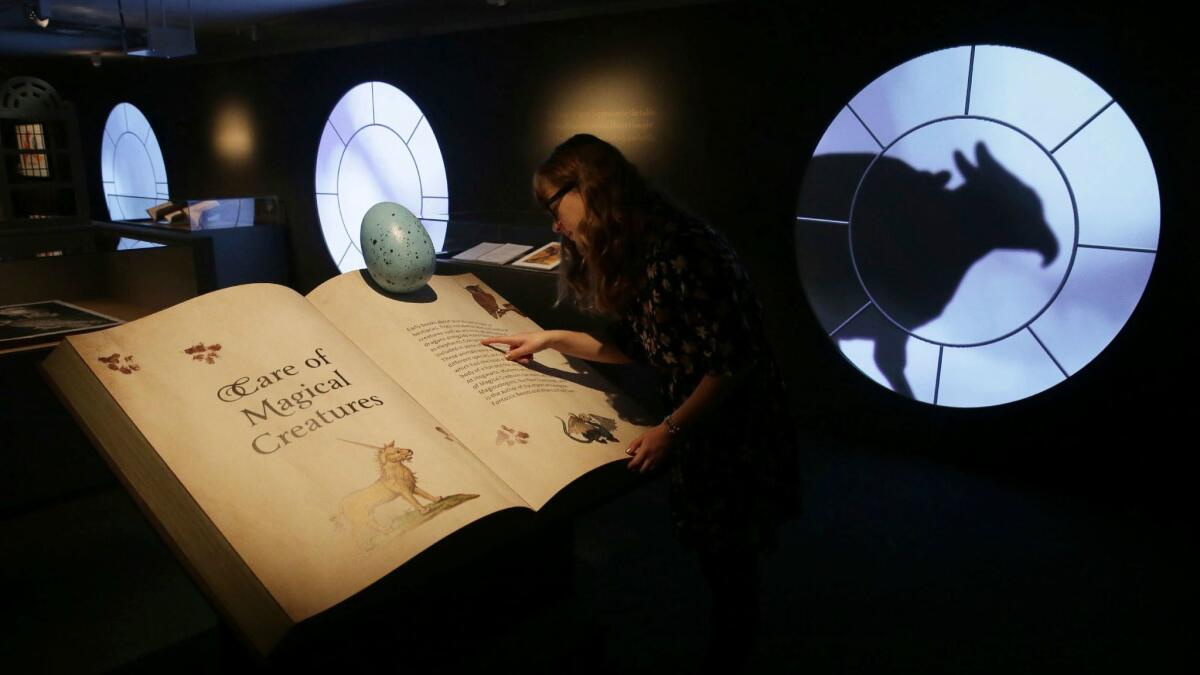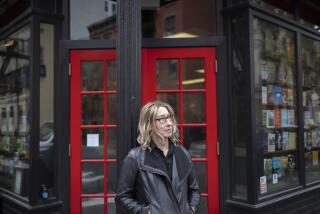The magic that inspired Harry Potter on display at the British Library

- Share via
Reporting from London — Magic is in the air at the British Library here — specifically the magical world of one of the most famous characters in modern literature, Harry Potter.
“Harry Potter: A History of Magic,” a recently opened exhibition spotlighting rare books and artifacts that detail traditions of folklore and magic from around the world, coincides with the 20th anniversary of the publication of J.K. Rowling’s seminal novel “Harry Potter and the Sorcerer’s Stone.”
The immersive exhibition, which runs through February, spans several themed rooms, each ornately decorated for a subject studied at the Hogwarts School of Witchcraft and Wizardry, including “Potions,” “Divination” and “Defense Against the Dark Arts.” The idea is to look at the actual historical accounts and evidence of magic that may have inspired the fictional world of Harry Potter.
“The British Library approached J.K. Rowling’s representatives, and we agreed that it was the right moment,” said Julian Harrison, lead curator of the exhibit. “It’s a great way to actually mark that occasion, as well as explore the history of magic in a wider context. Subjects like potions, herbology and astronomy are fascinating, and there are so many things we could have chosen to accompany those.” had about a year to collect this exhibition, so we’ve done it in a very short time.”
The exhibition, which pairs works with interactive displays like personalized tarot card readings and potion creation, pre-sold more than 30,000 tickets, the highest in the library’s history. This is also the first time the library has featured an exhibition that centers on a living author. Twenty other public libraries around Britain will offer satellite exhibitions in coordination with “Harry Potter: A History of Magic,” and the exhibit will move to the New-York Historical Society in October 2018.
Items and manuscripts owned by the British Library are among the most compelling inclusions. Chinese oracle bones, on display in the “Divination” room, are the oldest items in the library’s collection, dating to 1192, and offer evidence that divination has been a global tradition for centuries. The Ripley Scroll, which originated in the 1500s, details a method for creating the Philosopher’s Stone, represented in the American versions of the Potter novels as the Sorcerer’s Stone. “Culpeper’s English Physician; and Complete Herbal,” compiled by Nicholas Culpeper and first published in 1652, was used by Rowling when researching the possible applications of Hogwarts’ fictionalized herbology studies.
The exhibit also features key items from other institutions, including the Battersea Cauldron, which was found in the River Thames and dates to 800 to 600 BC. On loan from the British Museum, it’s an example of how potions could have been prepared over time. The Musée de Cluny-Musée National du Moyen Âge in Paris lent a tombstone for Nicolas Flamel, a name that will be familiar to Potter fans. Flamel, who died in 1418 and was supposedly an alchemist, inspired the character that appears in Rowling’s novels.
“We felt we had a new angle to offer by exploring these historical traditions of magic and exploring mythological roots of them,” noted Joanna Norledge, co-curator of “Harry Potter: A History of Magic.”
The historical items are displayed alongside original drawings, diagrams and drafts by Rowling and Jim Kay, who illustrated the Potter novels. Rowling personally selected each piece from her own archives, including an early sketch of Hogwarts made by the author and a handwritten list of Hogwarts’ teachers and subjects. There also are notebook pages of initial drafts from some of the novels, a few of which weren’t included in the final books.
“I think our exhibition is quite interesting in that it locates and identifies historical precedents for some of the stories,” Harrison said. or instance, Ancient Greeks believed in basilisks and unicorns, which is incredible. We’re always inquisitive and I’d always urge people to explore and investigate. “Yes, we’d like as many Harry Potter fans to come to our exhibition as possible, but we think we’ve located the stories in the history of magic that are interesting to everyone.”
The original Harry Potter publishers, Bloomsbury and Scholastic, have released books to accompany the exhibit. The family-friendly “Harry Potter: A Journey Through a History of Magic” explains the artifacts and artwork on display at the library, while “Harry Potter: A History of Magic” is a more detailed coffee table tome created to celebrate the exhibition. Google Arts & Culture, which partnered with the British Library to augment a celestial globe from 1693 in the “Astronomy” room, plans to put the exhibit online later this year, said Suhair Khan of the Google Cultural Institute.
The project asks visitors to emphasize knowledge and history above all else. It’s also great fun, especially when you discover the tongue-in-cheek empty display case with an invisibility cloak” that’s been offered up by a private lender (who you’re jokingly meant to assume is Potter himself), and see the shadows of magical creatures moving past you in one of the final rooms.
“The role I see for this exhibition in the main aims of the library is that it’s such an inspiring exhibition,” Norledge said. “These objects tell fascinating, quirky, undiscovered stories about the history of magic, and I think everyone will want to learn more. Another big theme of this exhibition, alongside magic, is the search for knowledge and learning about our world. It’s through books and looking at these historical items that we can get there and learn more about where we are today and how we’ve gotten there.”
More to Read
The biggest entertainment stories
Get our big stories about Hollywood, film, television, music, arts, culture and more right in your inbox as soon as they publish.
You may occasionally receive promotional content from the Los Angeles Times.










